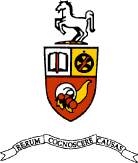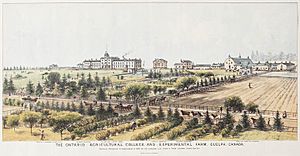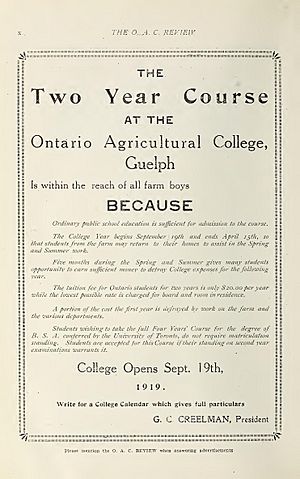University of Guelph facts for kids

Coat of arms of the university
|
||||
| Motto | Latin: Rerum cognoscere causas | |||
|---|---|---|---|---|
|
Motto in English
|
"To learn the reasons of realities" | |||
| Type | Public university | |||
| Established | May 8, 1964 (61 years ago) As constituents: OAC: (1874) Macdonald Institute: (1903) OVC: (1922) |
|||
| Endowment | CA$445 million (2023) | |||
| Chancellor | Mary Anne Chambers | |||
| President | Rene Van Acker | |||
|
Academic staff
|
830 | |||
|
Administrative staff
|
3,100 | |||
| Students | 28,415 | |||
| Undergraduates | 25,325 | |||
| Postgraduates | 3,090 | |||
| Location |
,
Canada
|
|||
| Campus | Urban 589 ha (1,455 acres) |
|||
| Colours |
|
|||
| Nickname | Gryphons | |||
|
Sporting affiliations
|
CIS, OUA | |||
The University of Guelph (often called U of G) is a big public university in Guelph, Ontario, Canada. It's known for its strong research and many different study programs. The university started in 1964. It was formed by joining three older colleges: the Ontario Agricultural College (from 1874), the MacDonald Institute (from 1903), and the Ontario Veterinary College (from 1922).
Today, the University of Guelph has almost 30,000 students. It offers many different degrees, from undergraduate (first degrees) to graduate programs (for advanced studies). The university is also a leader in research. For example, its Hospitality and Tourism Management program is top in Canada for research. Scientists at the university have made important discoveries. These include finding the first scientific proof of water on Mars. They also helped with the Barcode of Life project, which helps identify different species.
Contents
Discover the University of Guelph's History
The University of Guelph's story began a long time ago. In 1874, the Ontario government bought a large piece of farmland. They opened the Ontario School of Agriculture there. This school later became the Ontario Agricultural College (OAC) in 1880. It had classrooms, places for students to live, a library, and a dining room. The school also had an experimental farm and a museum. In 1874, they even started teaching about bees and beekeeping! This research continues today at the Honey Bee Research Centre.
In 1903, the Macdonald Institute was created. It taught women about home economics and other subjects. It was named after Sir William Macdonald, who helped fund it. Later, in 1922, the Ontario Veterinary College (OVC) moved to Guelph. It had been founded in 1862. These three colleges worked separately for many years.
On May 8, 1964, the Ontario government brought these three colleges together. This created the single University of Guelph. The university became known for its strong agricultural and veterinary programs. Over the years, the university grew and added more colleges. These included the College of Arts and the College of Biological Sciences. This helped the university offer even more subjects to students. The university is named after the city of Guelph. The name "Guelph" comes from an old European family name, linked to King George IV.
Explore the University Campuses
Main Campus: A Hub of Activity
The main campus of the University of Guelph is a busy place. Campus safety is important here. The University of Guelph Campus Community Police and other teams help keep everyone safe.
Ontario Agricultural College (OAC) Locations
The Ontario Agricultural College (OAC) used to have many campuses and research stations. These were all over Ontario. Some courses were taught in English and some in French. In 2014, the university decided to close academic programs at its Alfred and Kemptville campuses.
Today, the OAC still operates in Guelph and at a campus in Ridgetown, Ontario. The Ridgetown campus focuses on hands-on learning. It offers two and three-year diploma programs. These programs teach about agriculture, veterinary technology, and environmental management.
University of Guelph-Humber: A Unique Partnership
The University of Guelph-Humber is a special campus in Toronto. It was created in 2002. It's a partnership between the University of Guelph and Humber College. Students there can earn both a university degree and a college diploma at the same time. This campus had over 4,000 students in 2015.
Academic Life and Facilities
Special Graduate Programs
The University of Guelph works with other universities on special programs.
- The Guelph-Waterloo Centre for Graduate Work in Chemistry and Biochemistry (GWC2) is a large graduate school.
- The Guelph-Waterloo Physics Institute (GWPI) is a joint program with the University of Waterloo.
Campus Buildings and Spaces
Many important buildings are on campus. The War Memorial Hall was built in 1924. It honors students who fought and died in the First World War. Johnston Hall, built in 1931, is a famous symbol of the university. Its clock tower can be seen from far away. It overlooks Johnston Green, a popular spot for sports and concerts.
Rozanski Hall, built in 2003, is a modern building. It has large lecture halls with advanced technology. The Science Complex opened in 2007. It's a huge facility for science teaching and research. It brings together physical, biological, and computer sciences. A new building for Pathobiology and Animal Health opened in 2010. It helps prevent diseases and solve health issues for both humans and animals.
The W.F. Mitchell Athletic Centre was updated and expanded in 2016. Students helped fund this project. The new center is 170,000 square feet. It has a large fitness room, many gymnasiums, and a rock-climbing wall. It's used by students, athletes, and the public.
Student Residences: Where Students Live
South Residence is the biggest place for students to live on campus. It houses 1800 students. It was built in 1968 by architect John Andrews.
McLaughlin Library: A World of Knowledge
The six-story McLaughlin Library is a great resource for students. It has over 400 computers. Students can access millions of books, films, and other materials. The library partners with 14 other academic libraries in Ontario. This means students have access to even more resources.
MacDonald Stewart Art Centre: Art on Campus
The MacDonald Stewart Art Centre is a public art gallery. It's partly sponsored by the University of Guelph. It has a collection of 4,000 artworks. Most of these are Canadian art from the 1700s to today. It also has a sculpture park.
University Rankings and Reputation
The University of Guelph is highly respected. In 2018, it was ranked 16th among the top 50 research universities in Canada. It has a five-star rating from Quacquarelli Symonds (QS), a group that ranks universities worldwide.
The Ontario Veterinary College at the University of Guelph is especially famous. In 2020, it was ranked No. 1 in Canada and No. 5 in the world by QS World University Ranking.
The Globe and Mail newspaper also ranked Guelph highly. It was in the top 3 in many categories for medium-sized universities. This included top spots for student residences and campus atmosphere. A 2012 study said the University of Guelph was Canada's most inventive university. This was based on how many new ideas and inventions came from its faculty.
Forbes magazine listed the university as one of Canada's Best Employers in 2019. They said Guelph is a top university for its strong academics and hands-on learning. The university's Sustainability MBA program was also ranked as the best in Canada and ninth in the world in 2018.
Working with Industries
The University of Guelph works with many different organizations.
- Canadian Space Agency (CSA): The CSA supports research at Guelph. This includes work on instruments used in space, like those on the Mars rovers.
- RIM: The university partners with Research In Motion (RIM), a technology company.
- Huawei: The university receives research funding from Huawei.
- Career Fair at Bingeman's Park: Guelph helps organize a large career fair. It's a team effort with other universities and colleges.
- OMAFA - University of Guelph Partnership: This agreement brings many research experts to the university.
- Emperor Investments: The university's business incubator helped Emperor Investments. This company created a special way for small investors to manage their money.
Student Life at Guelph
| Undergraduate | Graduate | |
|---|---|---|
| Male | 40.1% | 43.3% |
| Female | 59.9% | 56.7% |
| Canadian student | 97% | 85.4% |
| International student | 3% | 14.6% |
Students at the University of Guelph have many ways to get involved. Student groups are officially recognized by the university. These groups include:
- The Central Student Association (CSA)
- The Graduate Students' Association (GSA)
- Student unions for different colleges, like the College of Arts Student Union (CA-SU)
- Interhall Council (IHC), which represents students living in residence halls.
These main student groups help approve and support many smaller clubs. There are clubs for special interests, academic subjects, and even for each residence hall. Students living in residence halls also have a Residence Student Government called Interhall Council. They help plan activities and connect students with university services.
How the University is Organized
The University of Guelph is run by two main groups: the Senate and the Board of Governors. The Senate handles academic matters. This includes what programs are offered and how students are admitted. The Board of Governors takes care of the university's business side. This includes money, buildings, and staff.
Guelph Gryphons: University Athletics
The university's sports teams are called the Guelph Gryphons. They compete in the Ontario University Athletics (OUA) and Canadian Interuniversity Sport (CIS). The school colors are red, black, and yellow or gold. The mascot is a Gryphon named Gryph. The university offers 15 varsity sports for men and 15 for women. Many Guelph students take part in sports or fitness activities.
The Gryphons men's football team won a national championship in 1984. The men's lacrosse team won the Baggataway Cup in 2008. The Gryphons are especially known for their success in cross country running. The men's team won ten titles in a row (2006–2014), and the women's team won eleven titles in a row (2005–2016). The field hockey team also won a national title in 2011.
Fun Campus Traditions
Painting Old Jeremiah: A Colorful Cannon
Old Jeremiah is an old British naval gun on campus. It sits in Branion Plaza. People say it was used in the War of 1812. After World War I, students brought it to campus to remember those who died. It's often called The Cannon. In the past, students from different majors would move the cannon around as a joke. It even showed up at another university once! Eventually, the university cemented it in place. But students still managed to aim it at the university's main administration building.
Since the 1950s, painting the cannon has become a big tradition. Students, sports teams, and clubs paint messages on it. These messages are often about upcoming events, birthdays, or even marriage proposals. There are unwritten rules for painting the cannon:
- Start painting after the sun sets.
- Finish before classes start in the morning.
- Don't use bad language.
- It's common to "guard" the cannon until sunrise to make sure no one paints over your message.
In 2010, an art student cleaned off all the layers of paint from the cannon. This was an art project approved by the university. Even though some students were sad to see the paint go, the tradition of painting Old Jeremiah quickly started again.
The Pep Rally: A Spirited Welcome
During the University of Guelph's orientation program, new students learn a special dance. It's called the Hall Boogie. They perform it to popular songs at a big event called the Pep Rally. Awards are given to the residence halls with the best spirit and dance moves. The Pep Rally is a very loud and energetic event!
In 2012, while the football field was being renovated, a "Rally for Change" was held instead. Students performed in the community to raise money for cancer research. This event has also become a tradition.
College Royal: An Annual Open House
Every March, the university holds an open house called College Royal. It's a popular event where the public can visit the campus. You can see everything from the barns of the Agricultural College to the sugar bush. It's especially popular with families during March break. In 2006, the TV show Rick Mercer Report even filmed a segment at College Royal.
Student Media
Students at the University of Guelph have their own media.
Newspapers and Magazines
- The Ontarion – a newspaper published every Thursday since 1951.
- The Peak
- Hornblower: The HTM Magazine – the official magazine for Hospitality and Tourism Management students.
- At Guelph – the university's official newspaper.
- The Portico – a magazine sent to alumni.
- Osnap – a monthly humor publication by the engineering society.
Radio
- CFRU-FM is a radio station for students and the Guelph community.
Former Student Media
- The Cannon – This used to be a student media website. Now, it's mainly a place for students to buy and sell things like housing and textbooks. Its name comes from the Old Jeremiah cannon on campus.
See also
 In Spanish: Universidad de Guelph para niños
In Spanish: Universidad de Guelph para niños
- Canadian government scientific research organizations
- Canadian industrial research and development organizations
- Canadian Interuniversity Sport
- Canadian university scientific research organizations
- Higher education in Ontario
- List of Ontario Universities
- Muck Crops Research Station
- Ontario Student Assistance Program
- University of Guelph Arboretum











